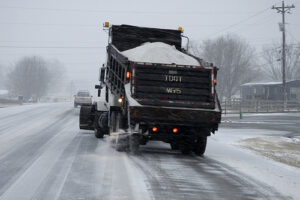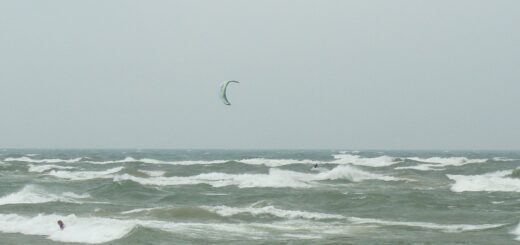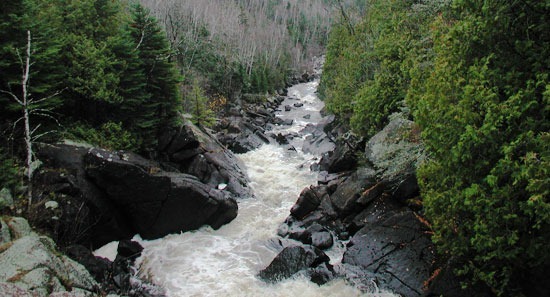Road salt is used nearly every winter as urban areas treat their roadways for incoming snowfall and ice events. The salt—one of several chloride (Cl–) compounds—commonly used to keep snow from accumulating during the winter, often moves over the land and enters waterways as runoff during precipitation or melt-off events. This loading leads to increased chloride concentrations which can impact other water quality parameters.
Inorganic chloride, like calcium chloride (CaCl2), magnesium chloride (MgCl2) and potassium chloride (KCl), are known to be chronically toxic to aquatic organisms as well as leading to changes in lake algal populations, decreases in lake mixing as well as declines in physical and chemical soil qualities. In the Great Lakes Basin, one of the main concerns surrounding chloride pollution is how this loading will impact the region’s tributaries.

Oregon DOT announced a change in the use of road salt to combat ice (Credit: Oregon Department of Transportation via Flickr CC BY 2.0)
Road salt is “the single largest use of salt in urban cold region environments,” making it a point of concern for researchers hoping to assess chloride concentrations in aquatic systems.1 While the impacts of chloride in aquatic systems are generally understood, there is limited comprehensive research regarding the contribution of chloride in groundwater to surface water systems.
A 2023 article published in the Journal of Great Lakes Research sought to fill and identify knowledge gaps regarding assessing groundwater as a potential source of road salt. The study synthesizes existing groundwater chloride research in the Lake Ontario Basin. Providing a comprehensive compilation of chloride concentrations and road salt conditions in the Great Lakes Basin help build a better understanding of the magnitude of groundwater chloride issues in the basin.
Methods
First, the research provides an overview of the various sources of Cl– in groundwater, the chemical properties of chloride, source characterization, pathways of transport, and impacts of excessive chloride. Next, past research in the basin was investigated, focusing on Lake Ontario and watersheds within the Canadian side due to existing trends in chloride-related studies.
Previous research was grouped together based on their focus into the following categories:
- Groundwater studies
- Mass balance or baseflow studies that aim to evaluate retention in aquifer systems
- Direct contribution to the lake research
- Larger-scale system studies
Each of these are integral to understanding chloride concentrations in the Great Lakes. Identifying the contributors, impacts and prevalence throughout the region are all critical to determining appropriate mitigation measures for freshwater ecosystems impacted by increased concentrations.

Road salt (Credit: Thomas Brueckner via Flickr CC BY 2.0)
Results
The study identifies the following four pathways as mechanisms for road salt transport to aquatic systems. First, de-icer applications such as chloride-bearing salts applied to impervious surfaces like roads can directly enter waterways. Second, chloride can be transported from the land due to runoff events wherein the output is not intercepted by storm sewer systems, adjacent drainage ditches, streams and wetlands.
Third, chloride can be transported by interflow, through which chloride “infiltrates into the shallow subsurface and is laterally transported to a stream channel or the surface downslope.” 1 Finally, the long-term pathway of chloride is represented by recharge to groundwater, deeper transport in groundwater and ultimate discharge as baseflow.
The compiled data revealed that surface water runoff is the dominant pathway in the winter and early spring, resulting in immediate increases in chloride concentration in exposed waters. Long-term pathways are deeper and slower, resulting from salt applied in previous years and become evident in the summer and early fall.
While a majority of chloride research is focused on urban watersheds, the article warns against excluding rural regions as contributors. Monitoring in more diverse areas and developing a deeper understanding of the chemical properties of chloride, source characterization, pathways of transport and impacts of excessive chloride can all lead to the creation and implementation of new and more comprehensive management strategies.
Source
- Ceilidh Mackie, Rachel Lackey, Jana Levison, Luciana Rodrigues. Groundwater as a source and pathway for road salt contamination of surface water in the Lake Ontario Basin: A review. Journal of Great Lakes Research. Volume 48, Issue 1, 2022. Pages 24-36. https://doi.org/10.1016/j.jglr.2021.11.015.








[…] leads to unsafe road conditions and future runoff events that will likely carry contaminants like road salt or pollutants. Poor road conditions can lead to multi-vehicle collisions or isolated crashes that […]
[…] not stratify on a density gradient to a meaningful degree. However, due to the influx of runoff, road salt, and other pollutants, stormwater retention ponds and other shallow waters located near urban […]
[…] in waterways throughout the Great Lakes and nearby Ontario surface and groundwaters. Runoff, the increased use of road salt, and other anthropogenic stressors have led to increases in chloride concentrations throughout […]